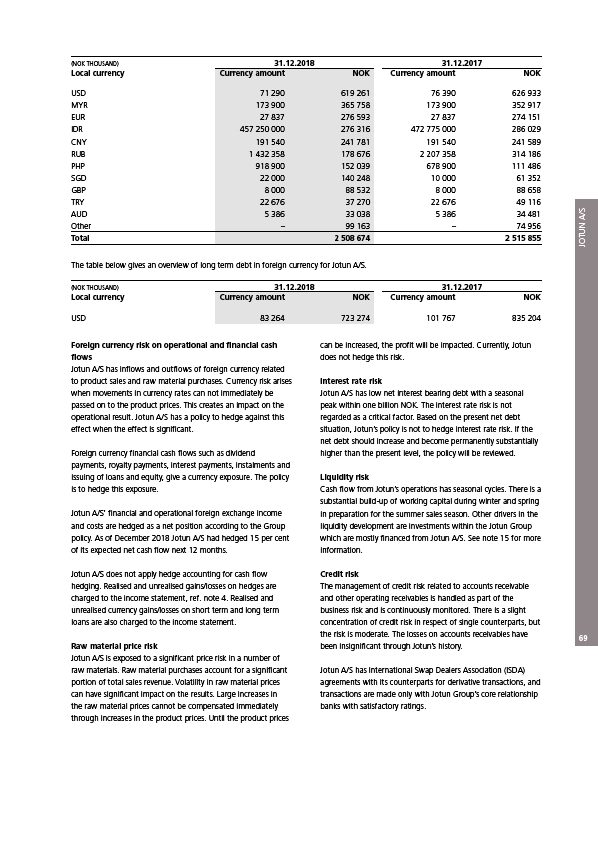
JOTUN A/S
69
(NOK THOUSAND) 31.12.2018
31.12.2017
Local currency Currency amount NOK Currency amount NOK
USD 71 290 619 261 76 390 626 933
MYR 173 900 365 758 173 900 352 917
EUR 27 837 276 593 27 837 274 151
IDR 457 250 000 276 316 472 775 000 286 029
CNY 191 540 241 781 191 540 241 589
RUB 1 432 358 178 676 2 207 358 314 186
PHP 918 900 152 039 678 900 111 486
SGD 22 000 140 248 10 000 61 352
GBP 8 000 88 532 8 000 88 658
TRY 22 676 37 270 22 676 49 116
AUD 5 386 33 038 5 386 34 481
Other – 99 163 – 74 956
Total 2 508 674 2 515 855
The table below gives an overview of long term debt in foreign currency for Jotun A/S.
(NOK THOUSAND)
Local currency Currency amount NOK Currency amount NOK
USD 83 264 723 274 101 767 835 204
Foreign currency risk on operational and financial cash
flows
Jotun A/S has inflows and outflows of foreign currency related
to product sales and raw material purchases. Currency risk arises
when movements in currency rates can not immediately be
passed on to the product prices. This creates an impact on the
operational result. Jotun A/S has a policy to hedge against this
effect when the effect is significant.
Foreign currency financial cash flows such as dividend
payments, royalty payments, interest payments, instalments and
issuing of loans and equity, give a currency exposure. The policy
is to hedge this exposure.
Jotun A/S’ financial and operational foreign exchange income
and costs are hedged as a net position according to the Group
policy. As of December 2018 Jotun A/S had hedged 15 per cent
of its expected net cash flow next 12 months.
Jotun A/S does not apply hedge accounting for cash flow
hedging. Realised and unrealised gains/losses on hedges are
charged to the income statement, ref. note 4. Realised and
unrealised currency gains/losses on short term and long term
loans are also charged to the income statement.
Raw material price risk
Jotun A/S is exposed to a significant price risk in a number of
raw materials. Raw material purchases account for a significant
portion of total sales revenue. Volatility in raw material prices
can have significant impact on the results. Large increases in
the raw material prices cannot be compensated immediately
through increases in the product prices. Until the product prices
can be increased, the profit will be impacted. Currently, Jotun
does not hedge this risk.
Interest rate risk
Jotun A/S has low net interest bearing debt with a seasonal
peak within one billion NOK. The interest rate risk is not
regarded as a critical factor. Based on the present net debt
situation, Jotun’s policy is not to hedge interest rate risk. If the
net debt should increase and become permanently substantially
higher than the present level, the policy will be reviewed.
Liquidity risk
Cash flow from Jotun’s operations has seasonal cycles. There is a
substantial build-up of working capital during winter and spring
in preparation for the summer sales season. Other drivers in the
liquidity development are investments within the Jotun Group
which are mostly financed from Jotun A/S. See note 15 for more
information.
Credit risk
The management of credit risk related to accounts receivable
and other operating receivables is handled as part of the
business risk and is continuously monitored. There is a slight
concentration of credit risk in respect of single counterparts, but
the risk is moderate. The losses on accounts receivables have
been insignificant through Jotun’s history.
Jotun A/S has International Swap Dealers Association (ISDA)
agreements with its counterparts for derivative transactions, and
transactions are made only with Jotun Group’s core relationship
banks with satisfactory ratings.
31.12.2018
31.12.2017